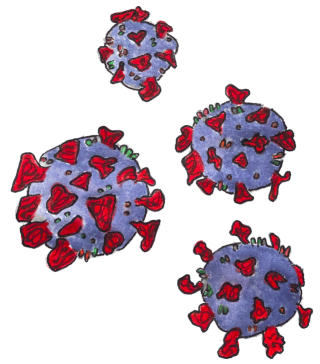Yale researchers investigate immune response in severe COVID-19 cases
Researchers at the Yale School of Medicine use single-cell multi-omic technology to peer into the immune responses of patients suffering from severe COVID-19 symptoms.

Sarah Eisenberg, Contributing Illustrator
Researchers at the Yale School of Medicine are investigating how immune responses differ in patients with severe COVID-19 side effects.
In an interdisciplinary undertaking, over 40 researchers from five laboratories at the Yale School of Medicine collaborated to investigate how immune responses among patients with severe COVID-19 that progressively worsens differ from those of patients who improve. The researchers studied the blood cells of these patients and discovered that, in progressive patients, there is a dyssynchrony in the immune response between the two major parts of the immune system, as well as an increase in type I interferon signatures, proteins that activate an immune response. To do this, these researchers turned to the novel technology of multi-omics.
“[Multi-omics] is the new way of doing science that, to me, changes the paradigm,” said David A. Hafler, chairman of the neurology department, professor of immunobiology at the Yale School of Medicine and senior author of the study.
Single-cell multi-omics allows scientists to analyze the function of individual cells through gene expression-based profiling. Tomokazu S. Sumida, the paper’s co-first author and assistant professor at Yale School of Medicine, explained that “determining this gene expression is very central for determining cellular function” because genes code for proteins, and proteins are what carry out functions.
Before this technology, researchers had to decide what specific proteins to target prior to the study. Single cell multi-omics allows for a non-hypothesis oriented approach which gives an “unbiased view of what’s there,” according to Hafler.
In this study, researchers analyzed the blood cells of patients with COVID-19 pneumonia using a cross sectional method. They took cells at two different points of the virus’ development in every patient and found that in progressive patients, “there is a dyssynchrony between the two arms of the immune system,” explained Avraham Unterman, the study’s other co-first author and former member of Yale’s Kaminski Lab.
These two arms are the innate immune system and the adaptive immune system. The innate system is the first defense mechanism that fights viral infections. It is non-specific and fast acting. The adaptive is a specialized immune response designed to only target the specific virus on hand. It is therefore a more powerful defense.
In a synchronous immune system, the innate component presents the antigens to the adaptive component. The specific immune cells that are involved in this presentation function are called monocytes, which present the antigens to adaptive immune cells called T cells.
The researchers found that, in patients with severe, progressive COVID-19, the monocytes do not effectively present antigens to T cells, but the adaptive immune system is still very active. Charles Dela Cruz, associate professor and director of the Center for Pulmonary Infection Research and Treatment at Yale, explained that this activity increases the inflammatory response of the immune system, which can have damaging effects to the rest of the body’s tissues. This finding relates to current COVID-19 treatment in severe cases, which is to give patients steroids that lessen the adaptive immune system’s response.
In patients with progressive COVID-19, there are more type I interferon signatures in both immune system cell types, which are released by infected cells. Sumida explained that it is widely agreed upon that type I interferons may be involved in facilitating antigen presentation, but that the mechanisms of its function are complex because it is highly context dependent. Furthermore, in the case of severe patients, the level of interferon signatures is higher than it should be during the resolution of the disease, which contributes to a damaging immune response.
Dela Cruz explained that this interaction between the monocytes and T cells could be targeted, which could aid in the treatment of severe COVID-19. He also explained that, through the use of multi-omic technology, researchers know the specific subsets of immune cells that are represented in progessive patients, so they know exactly what to target.
According to Sumida, if scientists are able to tweak the innate or adaptive immune system, they might be able to “rewire what is happening in severe patients.”
Sumida discussed the possibility of injecting patients with interferons in the early stages of the disease to assist their immune response. However, this would not be a viable treatment for patients who have developed severe COVID-19 because injecting the interferons at that later stage would exaggerate the immune response, contributing to the damaging bystander effects.
“Science doesn’t work in a straight line,” Hafler said when explaining the broader implications of their findings. Both Hafler and Sumida emphasized the surprising similarity between immune responses in severe COVID-19 and those in patients with cancer. According to Hafler, this overlap is a “beautiful example of how this horrible pandemic is teaching us about, for example, cancer, in unexpected ways.”
On Feb. 13, the CDC reported 34,034 new COVID-19 cases in the US.







